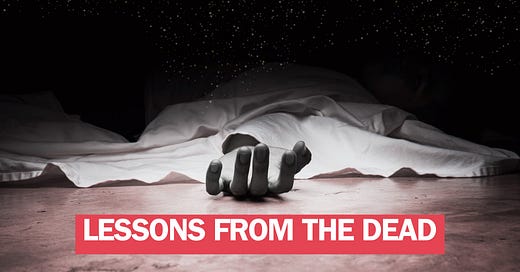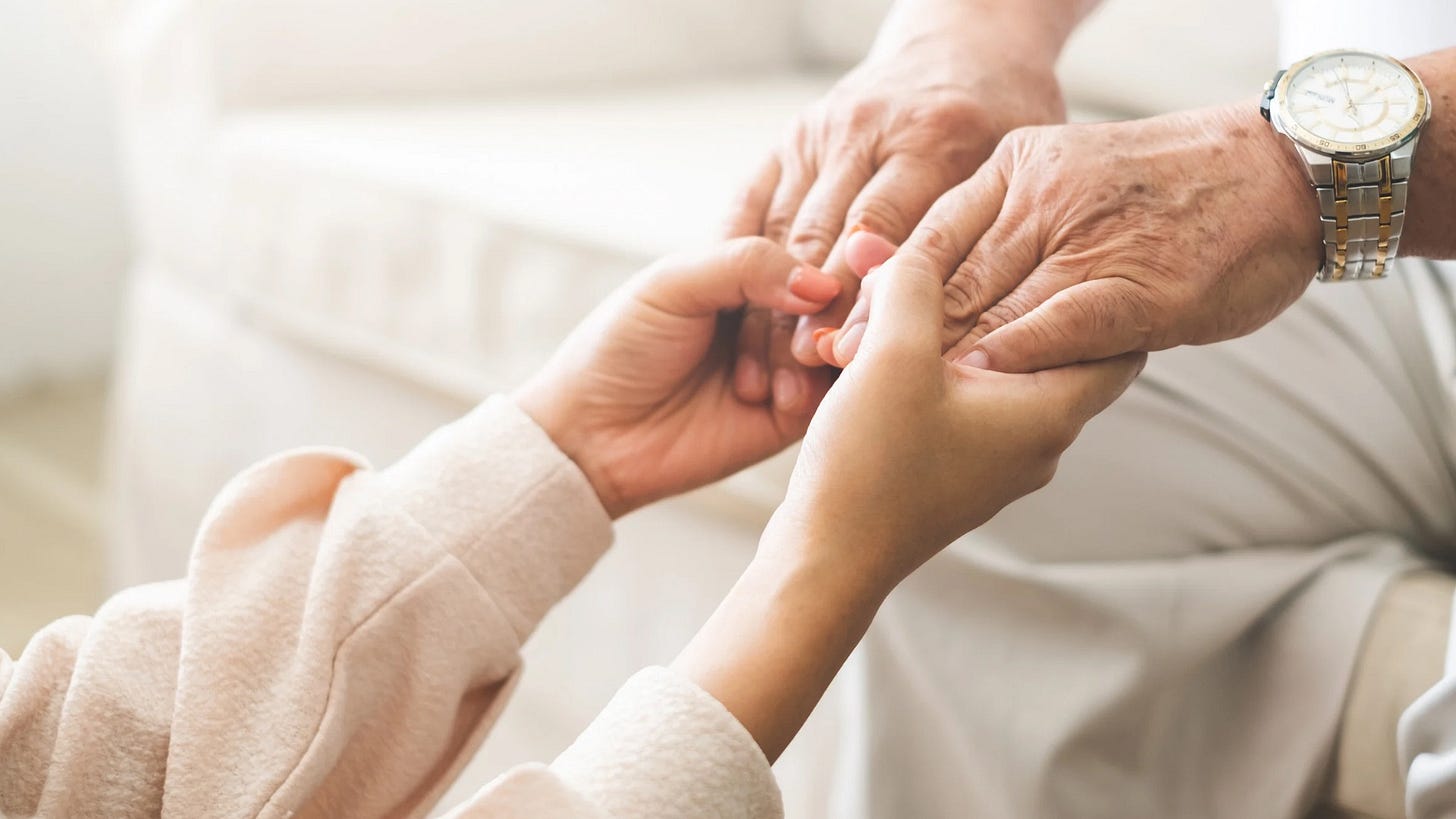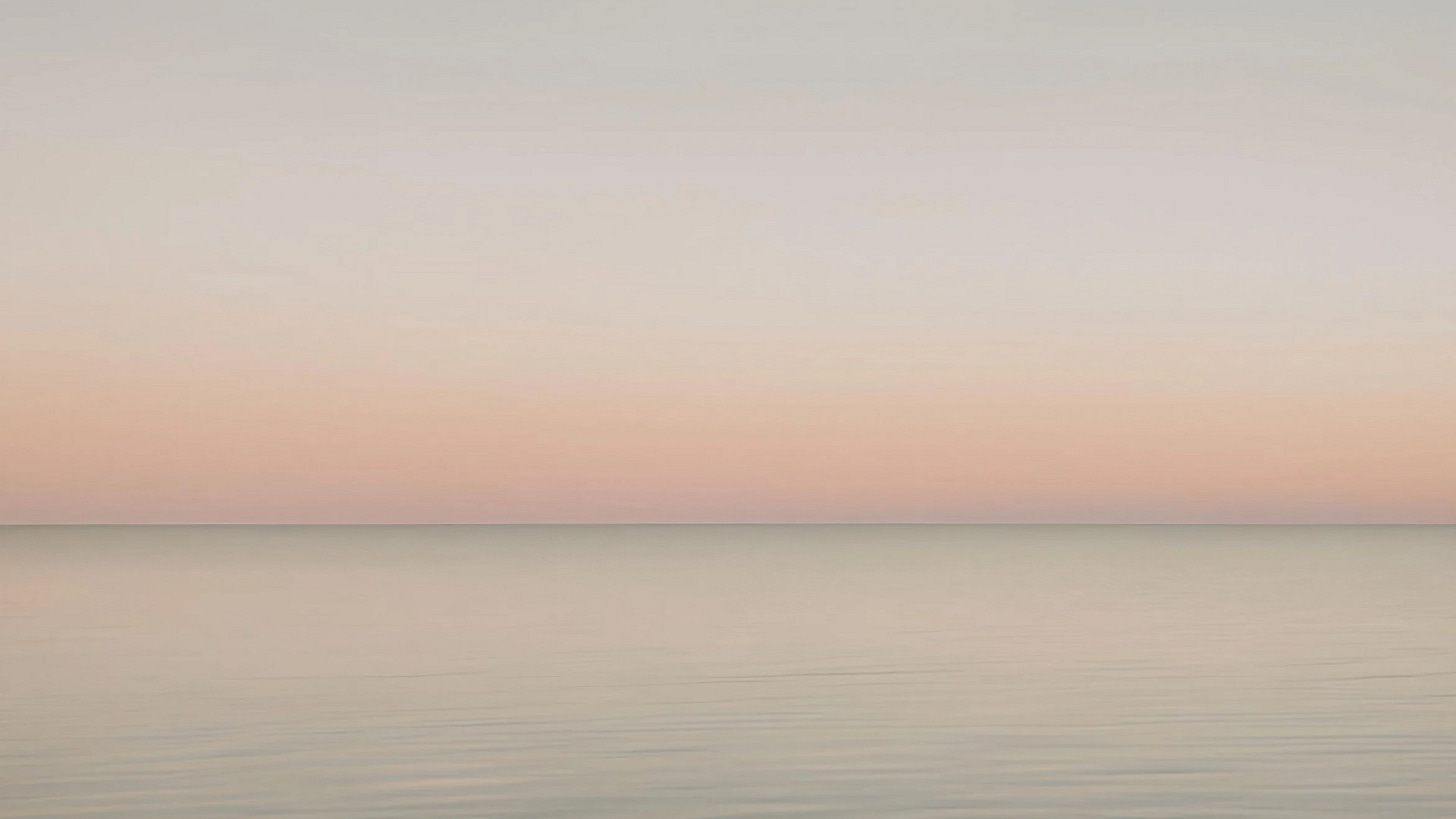Since childhood, I’ve been fascinated by death: what happens to our bodies leading up to it, what precedes it, and how it affects those closest to us after we’re gone. I’m not sure what kicked off this insatiable curiosity. Maybe it was losing my great-grandmother at nine, seeing her oily, strongly scented, and embalmed body in the casket as my family grieved behind me. Perhaps it was losing friends to suicide when I was twelve and sixteen, trying to understand how a young and vibrant body could suddenly be gone. Or maybe it was from watching the way death was portrayed in the media I consumed—movies like Fried Green Tomatoes, My Girl, The Cure, and Casper.
Death, for me, has always been the great and mysterious unknown.
For years, despite my inquisitive nature, I’ve been terrified of death. I’m not just afraid of what comes after, but rather of what those final moments will be like: the last pain, the last breath, and the last thoughts. In my fear, I’ve often fantasized about finding the fountain of youth or an ancient genie who could grant everlasting life. I may have even thought about being changed by some sexy immortal being, like something you’d see on Buffy or Twilight. But, as most of us know, life is much more boring than such fantasies.
The reality is that 56 million people die each year. On average, that’s 150,000 each day and about two people every second. The most common reasons for death are due to cancer, cardiovascular events such as a heart attack or stroke, and chronic respiratory diseases like COPD, asthma, and pneumonia. Less common events are dying by electrocution, perishing by sunstroke, or in a natural disaster. I hope to go in my sleep—maybe while dreaming of something pleasant and exciting, and pain-free, of course.
Regardless of how we die, death—the inevitable bastard—comes for us all.
I would have never predicted my career changing from arts management to healthcare at the end of 2013. At the time, I was not only going through a divorce but had also just moved back to my hometown and was looking for new employment. A friend (and previous coworker) convinced me to apply for an open position at the large nonprofit hospice where she worked. I was reluctant—who wants to work with dying people?!—but I applied—I have to work, right?!—and was eventually interviewed for the position. When I was offered the role, I was excited for the challenge, but honestly thought it was just for now. You know, something to do until my dream role came around. Now, nearly twelve years later, I’m still in the field and love what I do.
I’m not a clinician, but my role has always given me the freedom and opportunity to be present with patients and families at the end of life. I’ve even assisted in various ways during bereavement and spiritual distress and have coordinated volunteers to assist with vigil and bedside visits. Often people ask me how I work in this field—“It has to be so depressing to be around dying people all the time.” I try to convey that it’s an honor, a privilege, to be with people at the end of their life. Most of the time, what I witness is great love, humor, and unwavering support. It’s quite beautiful really.
That’s not to say there are no difficult cases: late-stage diagnosis, family turmoil, or advanced directive drama. I’ve witnessed families who’ve kept the terminal diagnosis of a loved one secret, even from the patient. Watched siblings fight bedside over their parents’ belongings or finances. Listened to families who had to fight with their employers, begging for time off to be there in those final moments. Talk to anyone in the end-of-life sector, and I’m sure you’ll hear a variety of “OMG!” stories. For many of us, what we take from these types of situations is a deep appreciation for each day, each moment. And most of us can let the small things go to prioritize the bigger issues.
If you were to look at my bookshelf, you would see a wide arrangement of books: memoirs and biographies, YA, humor, and a variety of nonfiction novels on death & dying. I have books about near-death experiences, hospice & palliative care, funeral traditions from around the world, theories on the afterlife, and even books that speak to the process of body decomposition in its many forms.
Throughout my reading, I have looked for hidden clues and overarching themes on death—the pain, the peace, torture, or the euphoric sense of oneness or home—and have been pleasantly surprised to see that in the last ten years, more books are covering these topics and inspiring conversation to help the stigma many of us carry.
Here are a few I’ve enjoyed and highly recommend for those of you, like me, who are curious about death, dying, and grief. I promise they’re not dull or boring, either.
For Those Curious About Death and the Body
Stiff: The Curious Lives of Human Cadavers by Mary Roach
“I began thinking about my skeleton, this solid, beautiful thing inside me that I would never see.”
This award-winning book was originally released in 2003 and has, for over 20 years now, remained a best-selling book.
Mary Roach has made an impressive career of writing books that blend her unique humor with science and curiosity. She asks the questions that most children are unafraid to ask and that many adults still think about. Honestly, she may just be my favorite author, with such books as Packing for Mars: The Curious Science of Life in the Void, Gulp: Adventures on the Alimentary Canal, and Fuzz: When Nature Breaks the Law.
What makes Stiff her best work to date is her no-bar approach to the human body. If you’ve ever wondered what happens to a body during natural decomposition, this is it. Curious what happens during embalming or cremation? What about what happens to a body that perishes in a car or an airplane crash? Roach covers everything from body snatching to cannibalism with respect and scientific inquisitiveness, so that no matter how morbid it sounds, you can’t stop reading. My favorite chapters were Crimes of Anatomy, which covers cadavers throughout history, and How to Know If You’re Dead, which is pretty self-explanatory. I highly recommend this book.
Funeral Rituals From Around the World
From Here to Eternity: Traveling the World to Find the Good Death by Caitlin Doughty
“Show me the manner in which a nation cares for its dead and I will measure with mathematical exactness the tender mercies of its people, their respect for the laws of the land and their loyalty to high ideals.”
Author and California mortician Caitlin Doughty has traveled throughout the world exploring other cultures to witness how we care for the dead. What she found was beautiful and diverse customs that provided dignity well beyond death.
Growing up in a rural community, I never realized there were so many ways to care for the dead. For me, a funeral always consisted of the same formula: embalming, a possible open casket service, and burial in the local cemetery. It took years for me to understand how vast funeral customs were and could be.
This book is utterly fascinating, beautifully written, and full of facts and interesting tidbits. Like Roach, Doughty brings her inquisitive nature and wit to the fold, which makes this an easy, fun, and fast read. My favorite chapters were on Indonesia and Bolivia, whose funeral rituals go well beyond death for many, many years.
You can also check out Caitlin Doughty’s other great novels, Smoke Get’s in Your Eyes and Will My Cat Eat My Eyeballs.
Understanding the Physician Perspective
Being Mortal: Medicine and What Matters in the End by Atul Gawande
“Our ultimate goal, after all, is not a good death but a good life to the very end.”
During the end-of-life journey, it’s easy to place our frustration and anger on those in the medical field. Maybe our doctors caught our diagnosis late or refused to care for us when intuitively we knew something was wrong. This book sheds light on the struggles within the medical profession and what it will take to shift its culture.
Gawande, a surgeon, uses research, patient stories, and the vulnerability of his loss to look closer at his role at end-of-life. He believes we must teach the next generation of clinicians that “the ultimate goal is not a good death but a good life—all the way to the very end.” This book is not only eye-opening but incredibly moving. And if you don’t want to read the book, you can watch the documentary online through PBS, which is just as good.
Knowing the People Who Do the Work
“You need to be able to separate the shock of seeing death from the shock of grief,”
I finished this book in January, and it’s by far my favorite read of the year. I’ve read many books about death & dying, as you now know, but I’ve never read anything that focused solely on the “exploration of the death industry and the people who work in it.”
I’ve always been curious as to how morticians, embalmers, or crime scene cleaners chose such a profession. What was it that drove them into this field, and has it changed them? Campbell, who has also been fascinated by death since childhood, not only asks these questions but spends time with those who care for our loved ones after death. Through her connections, she brings light to those who are often forgotten, and does it in a charming and honest way.
A Personal Grief Memoir That Transcends
Happy Death Club: Essays on Death, Grief, and Bereavement Across Cultures by Naomi Westerman
“…but maybe a good death means a good life. A life not full of unfulfilled dreams, or plans for the future that will never be realised.”
Fans of Caitlin Doherty’s 'From Here to Eternity' and Mary Roach’s 'Stiff' will love HAPPY DEATH CLUB by Naomi Westerman. This 96-page chapbook features essays that speak to Westerman’s grief (as she lost her entire family) and how death and bereavement are treated across cultures. For such a small book, I found this to be a remarkable collection filled with dark humor and engaging stories, written with heartbreaking humility.
I enjoyed every chapter/essay of this book, especially those that revealed the author’s relationship with her parents (and their deaths), but my favorite essay was Chapter 6: Fear & Loathing in Mexico City. Here, Westerman does a beautiful job contrasting her grief against the colorful backdrop of Día de los Muertos and how other cultures celebrate death with such color and - well, life. She does this notably while touching on death rituals from around the world, like the Bhutanese Buddhists, Cannibalism in the Amazon rainforest, and Ghana’s fantasy coffins. If you enjoy a good memoir filled with tidbits of knowledge to further pique your death curiosity, then I highly recommend this book.
I understand my curiosity around the realm of death & dying is mostly because that fear (of dying) still exists inside of me. When I read books like these, it helps me see the bigger picture. I understand how death is not only a journey for the deceased, but for those who are left behind.
My ultimate wish, outside wanting a painless death that doesn’t leave my loved ones with guilt or question, is that our society normalizes these types of conversations. That we can speak openly and honestly about our fears, our desires, and wishes for a good life, and a good death.
But, that’s what we all want, right?













